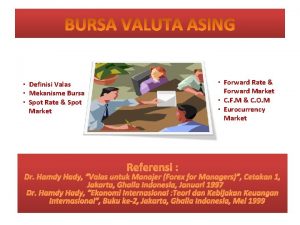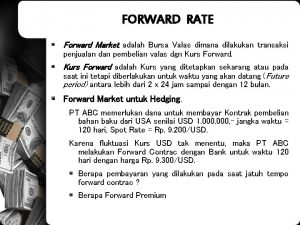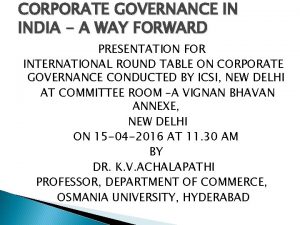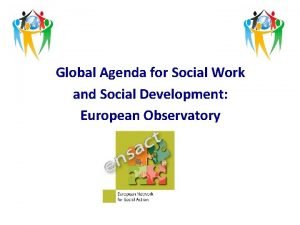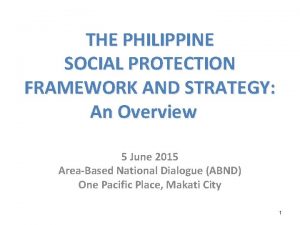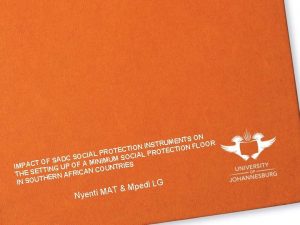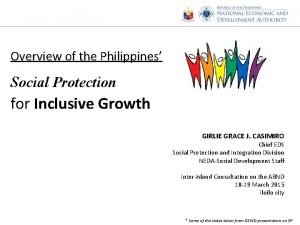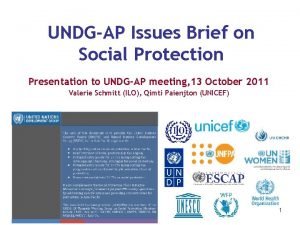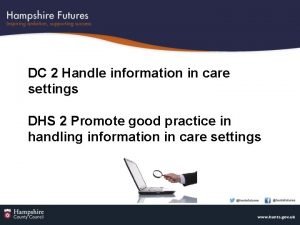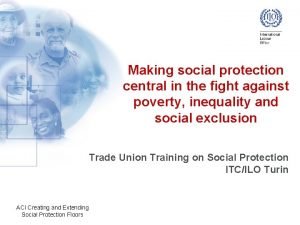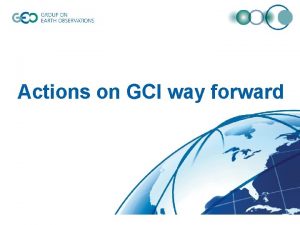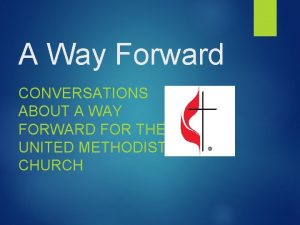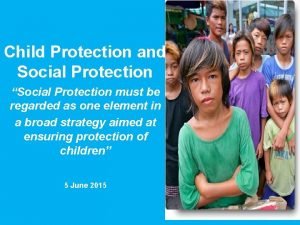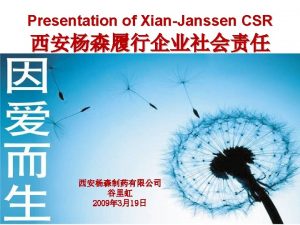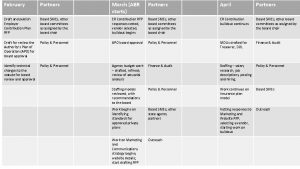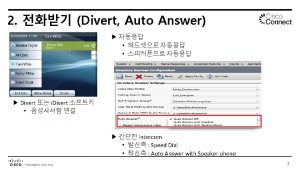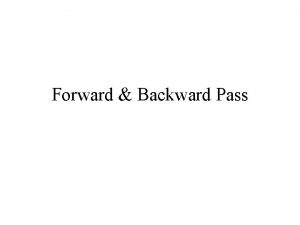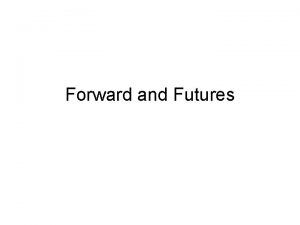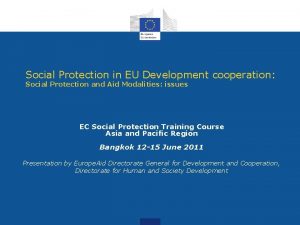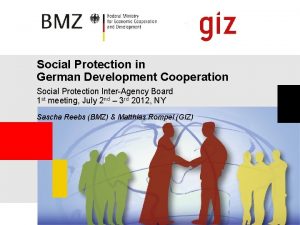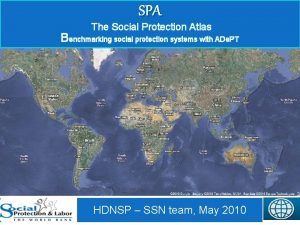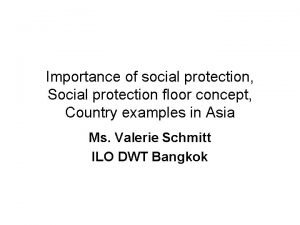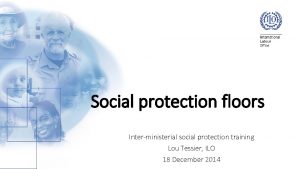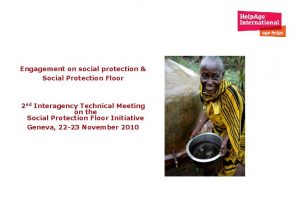Social protection the way forward for development partners
























- Slides: 24

Social protection: the way forward … for development partners? Nicholas Freeland Regional Hunger & Vulnerability Programme 24 -25 May 2011 Johannesburg

Outline q The GOOD q The BAD q U The FUTURE

The GOOD: SP in the new development paradigm q Traditional (the poor are the problem): o o q Focus development on economic growth Wait for economic growth to reduce poverty Residual interim safety nets Donor (expensive) emergency assistance where necessary … IS NOT WORKING (in Africa) Emerging (the poor are the solution): o o Provide comprehensive social protection Social protection will help to generate economic growth This will reduce poverty and the cost of social protection Reduced emergency assistance, freeing donor resources

The BAD: Development partners working together

Four Horsemen of the Donor Apocalypse Pro du ctiv ists u r t Ins n e m tal s t s i s r te n e rc e p n Te Un ive rsa list s

The White Horse: The Productivists q Proponents o World Bank q Characteristics o o q Proxy Means Testing Public Works Programmes Social Action Funds Conditional Cash Transfers Examples o Latin America, Philippines, Tanzania q Concerns o 3 Ps – but where is “provision”


The Red Horse: The Ten-Percenters q Proponents o UNICEF (parts) q Characteristics o Community targeting o Poorest ten percent (labour-constrained) o Unconditional Cash Transfers q Examples o Zambia, Malawi, Liberia, Zimbabwe q Concerns o No Ps: no practical basis, no political support, no potential

The Black Horse: The Instrumentalists q Proponents o ILO, WHO, UN family, et al q Characteristics o Decent Work/Employment o Social Protection Floor • • q Access to health services Child/family support Income support for unemployed Income security for elderly and disabled persons Examples o Mexico, Brazil, Argentina, South Africa, Bolivia, Sri Lanka, Ghana, Haiti, East Timor, etc, etc q Concerns o Which P? : Process or Prescription?

social protection floor initiative “There are no best solutions or ‘one-size-fits-all’ formulas to set up the SPF. Each country has different social needs, development objectives and fiscal capacity to achieve them, and will choose a different set of policies. Through a coordinated country response, the SPF facilitates and accelerates the introduction or strengthening of sustainable context-specific social protection systems. The Initiative supports countries in their efforts in building, expanding, extending or reorienting their social protection systems by offering high-quality/ low-cost technical assistance to countries through a mechanism of increased interagency collaboration”

The SPF concept and definition The 4 essential Social Security transfers: • all residents have access to a nationally defined set of essential health care services • all children have income security, at least at the level of the nationally defined poverty line level, through family/child benefits aimed at facilitating access to nutrition, education and care • all those in active age groups, who are unable to earn sufficient income on the labour market, should enjoy a minimum income security through social assistance • all residents in old age or with disabilities have income security at least at the level of the nationally defined poverty line through pensions for old age and disability

The social security component of the social protection floor could consist of four essential social security guarantees: International Labour Office Universal access to health care l all residents have …access to a nationally defined set of essential health care services; A minimum of income security over the life cycle l all children have income security through family/child benefits aimed at facilitating access to nutrition, education and care; l all those in active age groups who are unable to earn sufficient income on the labour markets should enjoy a minimum income security through social assistance …in link with employment policies l all residents in old age and with disabilities have income security through pensions for old age and disability. The ILO Global Campaign to Extend Social Security to All 12

The Social Protection Floor Global Initiative • The SPF is not only an innovative global concept, it is already a reality in an increasing number of countries • This includes many emerging economies (G 20): Mexico, Brazil, Colombia, Argentina, Chile, South Africa, India, Indonesia, China, Thailand, Philippines, Russia… • Some leading countries have already a comprehensive SPF in place: Mexico (Vivir Mejor- Seguro Popular), Brazil, Argentina, Uruguay (El Plan de Equidad) , Chile ( La Red de protección social : Protege), South Africa… • Others have started implementing important building blocks: India (RSBY, NGREGA), China (New Rural Cooperative Medical Scheme), Colombia (“Regimen subsidiado de salud”)… • Some low income countries are starting a SPF process: Bolivia, Peru, Ecuador, Paraguay, El Salvador, Sri Lanka, Ghana… Including some LDCs: Burkina, Togo, Benin, Senegal, Rwanda, Haiti, Mozambique, Tanzania, Zambia, Cambodia, East Timor, Nepal, Laos, Maldives… • A SPF is also relevant and exists in many high-income countries • SPF is a flexible and relevant tool at any stage of development

The Pale Horse: The Universalists q Proponents o INGOs, RHVP, some bilaterals q Characteristics o o q Rights-based Categorical targeting Employment Guarantee Schemes Unconditional Cash Transfers Examples o Nepal, Uganda (partial), Zambia (partial) q Concerns o 3 Ms: Money, money

Angels or demons? New kids on the block q European Commission o ERD 2010 – Social Protection for Inclusive Development o Social Transfers Reference Document q African Development Bank o Social Protection Strategy q Aus. AID o G 20 leadership on SP, with Indonesia o “Triangular” support • DP facilitation and funding • MIC expertise (South-South learning) • LIC benefit

The FUTURE: where next for development partners?


Principles (“Ten Tennessus Tenets”) 1. Recognise the importance of social protection 2. Support national policy priorities 3. Minimise policy intrusion 4. Rationalise donor support 5. Encompass a diversity of approaches 6. Focus on vulnerability 7. Limit pilot projects 8. Find new levers of support 9. Involve participants 10. Focus on outcomes

Start from government programmes and national visions q Social protection works where you have strong governments o o q Ethiopia Rwanda Botswana South Africa It works where you have strong civil society o South Africa o Bangladesh q It doesn’t work where you have strong donors o Malawi o Zambia o Senegal

Examples: 1) Lesotho Old Age Pension q What we should have done o o o q Supported the Government Offered funding to reduce the age from 70 to 60 Helped Govt explore child benefit using same channels Improved delivery systems Supported M&E to inform policy and learn lessons What we did o Said it was impossible and unsustainable o Ignored it – no funding, no tech support, no M&E o Set up separate OVC programme, using parallel systems

Examples: 2) Malawi Agricultural Input Subsidy q What we should have done o Supported the Government o Monitored, and explored options for cash transfers to those who sold their vouchers o Explored integrated ways to extend social transfers to those with no land or labour (cp. Ethiopia/Rwanda direct welfare support) o Explored innovative delivery systems q What we did o Said we didn’t like subsidies o Insisted that a national social protection policy be approved o Set up separate donor-funded SCT programme

Role for development partners q q Adhere to Paris Declaration and Accra Agenda Build capacity at national and sub-national levels Support civil society involvement in SP debate Fund one-off and start-up costs o o q q National identity systems Delivery systems Social audits and grievance procedures Leveraging private sector involvement M&E; impact assessment; evidence base Fund transfers – where necessary (Co. D? ) Expand transfers in response to shocks Support South-South exchange/lesson-learning


www. wahenga. net
 Contoh mata uang soft currency
Contoh mata uang soft currency Forward rate dan forward market
Forward rate dan forward market Low forward power protection
Low forward power protection Goal reality options way forward
Goal reality options way forward Way forward presentation
Way forward presentation Accenture development partnership
Accenture development partnership Global agenda for social work and social development
Global agenda for social work and social development Social thinking social influence social relations
Social thinking social influence social relations Social thinking social influence social relations
Social thinking social influence social relations One way table and two way table
One way table and two way table Two way anova
Two way anova Advantages and disadvantages of threaded binary tree
Advantages and disadvantages of threaded binary tree Perbedaan one way anova dan two way anova
Perbedaan one way anova dan two way anova What does one way anova tell you
What does one way anova tell you One way anova vs two way anova
One way anova vs two way anova Two way anova adalah
Two way anova adalah Principles of conventional software engineering
Principles of conventional software engineering One was a ship
One was a ship Walk this way talk this way
Walk this way talk this way Social protection operational framework philippines
Social protection operational framework philippines Social protection instruments
Social protection instruments Social protection operational framework philippines
Social protection operational framework philippines Social protection
Social protection Handling information in care settings
Handling information in care settings Ilo social protection
Ilo social protection
